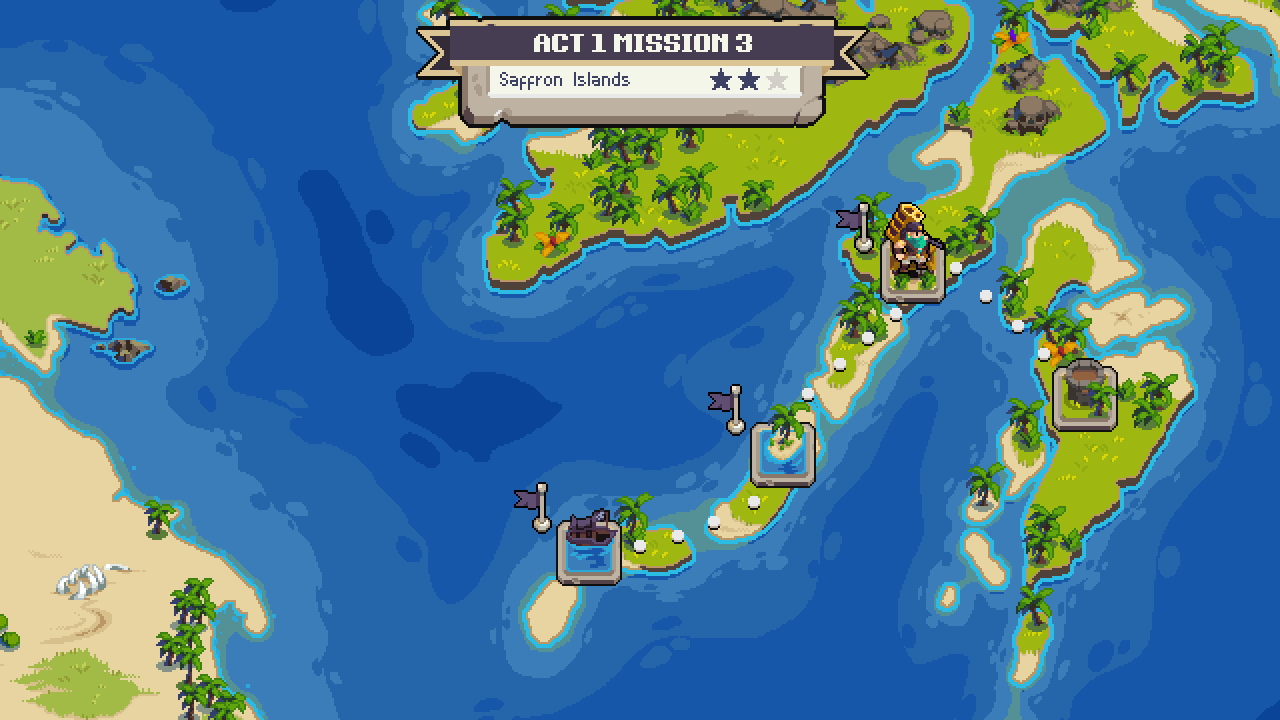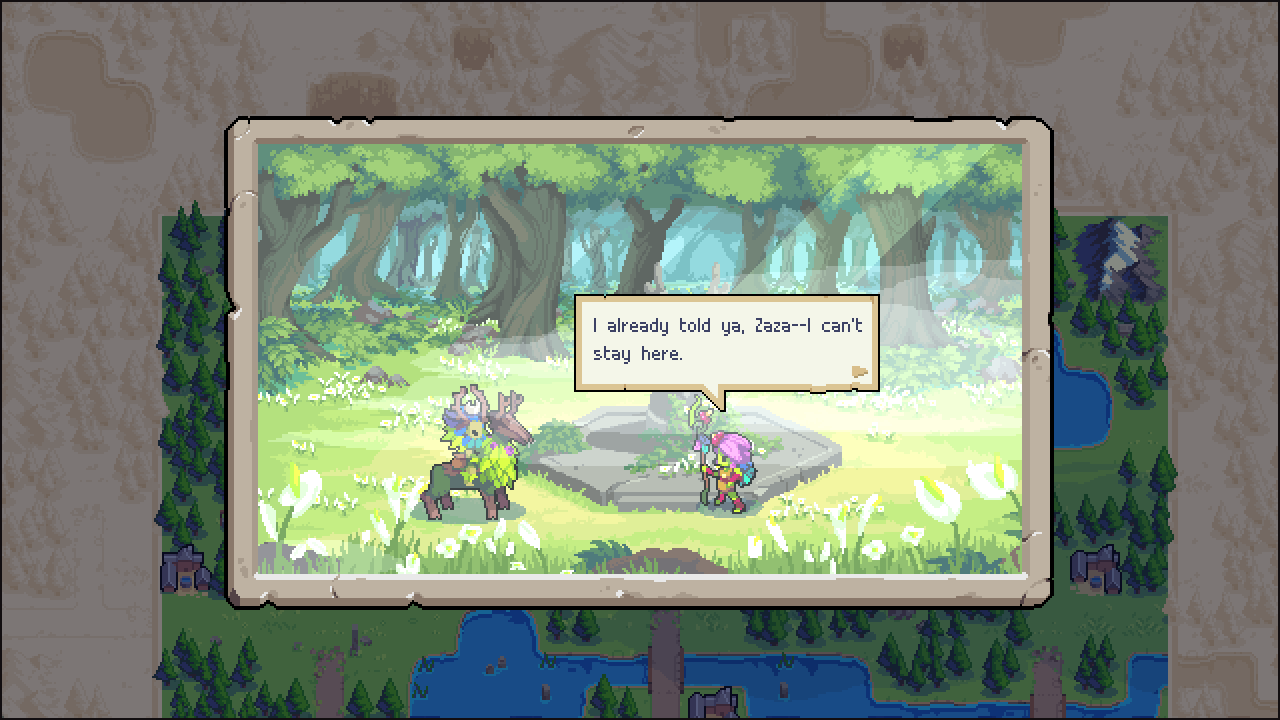The original Wargroove was a breath of fresh air for turn-based strategy fans. Nintendo’s colorful, cheery Advance Wars series took a darker, post-apocalyptic turn with 2008’s Days of Ruin and subsequently went dormant for over a decade. Developer Chucklefish stepped in with their take on the genre in 2019, building upon the core Wars gameplay style and structure in a new, fantasy-inspired setting with a robust suite of creation tools and modern multiplayer options. The game was a big success, and even saw some significant content updates with new commanders and an additional campaign designed for co-op. Now that Wargroove is an established name and Nintendo returned to the battlefield with Advance Wars 1+2 Reboot Camp just this year, my expectations for Wargroove 2 were higher than ever. I can happily say that Chucklefish and development partner Robotality have exceeded those high expectations, delivering a sequel that builds meaningfully on the world and narrative established in the first game to tell an engrossing, character-driven storyline touching on topics as varied as young love, the struggle of parental expectations and responsibility, and the evils of colonialism. On top of deftly handling such complex and emotionally resonant narrative subject matter, they also made some much-needed tweaks to the game’s structure to make the experience feel fresh for returning fans, without overloading new players.
Wargroove 2 picks up some time after the conclusion of the co-op campaign from the first title, and puts the player in the perspective of the game’s new faction, a race of anthropomorphic rodents from the Faahri Republic. The Faahri are a technologically advanced and highly intellectual society, and their expedition to Aurania is driven by a desire to uncover the lost technology of Aurania’s ancient kingdom, Cacophony. A young recruit named Lytra accompanies the enigmatic researcher Pistil and the stoic general Rhomb as they fight against the plant-like Floran to uncover ancient ruins for a mysterious benefactor.
This initial campaign introduces the player to the basic unit types and eases them into the mechanics with small army sizes, but keeps things interesting with varied objectives. Upon completion, the player can choose between three additional campaigns. The beginner campaign continues with the Faahri’s quest, another follows Prince Koji of Heavensong and the outlaw twins Errol and Orla in their quest to help Fell King Valder, and one follows the outlaw Wulfar as he travels to the eastern archipelago colonized by Heavensong. The final campaign is only available after completing all other campaigns, but the intermediate campaigns can be done in any order.
Each campaign focuses on a different type of combat; the Faahri campaign is designed around ground units, the Felheim campaign introduces air units, and the Outlaw islands campaign introduces naval units. One major criticism of the first title was that the first few acts of the campaign held the player’s hand too much. Wargroove 2 avoids this by splitting the various types of warfare into distinct campaigns, which ramp up in difficulty fairly quickly and do not overstay their welcome. By the time players make it to the final campaign, they will have a mastery over each unit type and have overcome steep challenges tailored to each type of warfare, just in time for the final confrontation to test their skill with them all at once.
Another way that the sequel improves immensely upon its predecessor is the storytelling. While the original Wargroove provided appropriate context for the conflict between the various countries of Aurania and delved into the world’s history in a satisfying way, it wasn’t particularly compelling on its own. However, Wargroove 2 has a greater focus on storytelling and character development, which surprised and delighted me. It builds upon the lore and relationships established in the first game to flesh out the characters and their motivations. As the end of the original conflict saw the various countries come together in an alliance, the nature of the conflict in the sequel is morally complex.
The Faahri are primarily on a learning expedition but find themselves consistently at odds with the Florans, who want the destructive powers of Cacophony’s secrets to remain buried deep in the ground. Lytra is torn between the ravenous and insecurity-fueled ambitions of the scholar Pistil and General Rhomb’s noble, cautious pragmatism as they fight Florans, unaware of the dangerous nature of the artifacts they unearth. The kingdom of Felheim is in chaos after Ragna, Valder’s Frankenstein-esque daughter, takes his Fell Gauntlet in a fit of rage under the weight of his expectations, becoming possessed by it and ushering in a blight known as the Fallow. Koji, Errol, and Orla rush to Valder’s aid, helping him reach his wayward heir to permanently quiet the dark influence of the gauntlet while a budding (queer) young love develops between Koji and Errol. On the other side of the globe, Errol & Orla’s father, Wulfar, is tasked by the kingdom of Cherrystone to investigate the Heavensong Empire’s island colonies and runs into the resistance group led by his late wife’s sister, Nadia. Wulfar joins their cause, fighting back against the Heavensong army after witnessing the harms wrought by their colonialist expansionism as he grapples with his relationship with his wife’s homeland and her kin.
While each campaign varies significantly in tone, each story feels as if it belongs in this world. The stories culminate in a satisfying conclusion that deals with distrust, insecurity, past trauma, and fear rather than outright villainy or malice. The nature of the conflict is deeply human, and each character has understandable, believable motivations, even if they are misguided. It’s rare to see an otherwise light, cartoony wargame with such strong character development, or handle emotionally heavy subject matter so deftly, but Wargroove 2 does so expertly enough to put higher budget titles to shame.

On the gameplay front, Wagroove 2 is content to take a more iterative approach to the systems established by the first game. The map and unit design still take most of their cues from Advance Wars, with the medieval fantasy aesthetic and on-field commander units giving the game a bit of its own identity. One issue that pervaded the first game was unit balance, and unfortunately, that largely hasn’t been addressed here. Wargroove 2 adds a slate of new unit types, most focused on utility. The Air and Sea categories each have a new, cheap unit capable of capturing structures (flamingos and riverboats, respectively), and three new sea animals flesh out naval combat and provide additional utility (sea turtles, octopi, and frogfolk). These units are nice but hardly feel necessary, and the addition of even more structure-capturing units when various types of ground infantry already dominate the game feels slightly misguided. Alchemists are still dominant due to their combination of strength, healing utility, high movement, and cheap cost, while other units like Pikeman remain underpowered. Commanders are still the best aspect of the game’s combat, and the new commanders and their Grooves feel well-considered and impactful. The core balance simply isn’t as tightly tuned as the Advance Wars series, and while the campaign offers enough variety in objectives and maps to alleviate these issues, I foresee multiplayer matches devolving into the same handful of dominant strategies.
Besides the story campaigns, Wargroove 2 offers the new Conquest mode and the custom creation suite. Conquest replaces the Arcade and Puzzle modes of the first game with a rogue-like inspired mode. Players will choose a commander and a starting band of soldiers, then progress through a set of procedurally generated nodes on the various conquest maps. Any soldiers who die are lost permanently, and the commander’s death results in a game over. By progressing in this mode, players acquire gems that unlock additional modifiers, bonuses, conquest maps, and commanders to play as. Conquest is an interesting endurance test, and on its own, it’s an inventive take on the core turn-based strategy formula. However, the loss of the more traditional, larger map conflicts of the Arcade mode is a shame. For that experience, players will have to check out the user-created campaigns.
The creation tools are as good as in the first title, letting players create their own maps and combine them into distinct, downloadable campaigns for other players to enjoy. The tools are simple to grasp but provide nearly endless possibilities, and the ability to browse campaigns and maps created by other users is a huge step up over the limited, friends-only sharing options in Advance Wars 1+2 Reboot Camp. The multiplayer experience also puts Nintendo to shame, offering actual lobbies and the ability to create public or private rooms with solid connections and no lag. If there is one way in which the Wargroove series has outdone its inspiration, it’s through providing a robust and friendly online experience that extends the longevity of the game immensely.
Wargroove 2 is, in many ways, an ideal sequel. It uses the fertile groundwork laid by its predecessor to cultivate an impactful and emotional narrative, drawing on players’ attachment to its characters and world as an opportunity to explore each in much greater detail with a satisfying and heartfelt payoff. It makes some nice tweaks to the campaign structure and provides enjoyable additions without reinventing the wheel, for better and worse. The user-generated content tools and solid multiplayer options will ensure Wargroove 2 is a platform for great stories and fun challenges for years to come, and I wholeheartedly recommend the game to any fan of turn-based strategy games.





